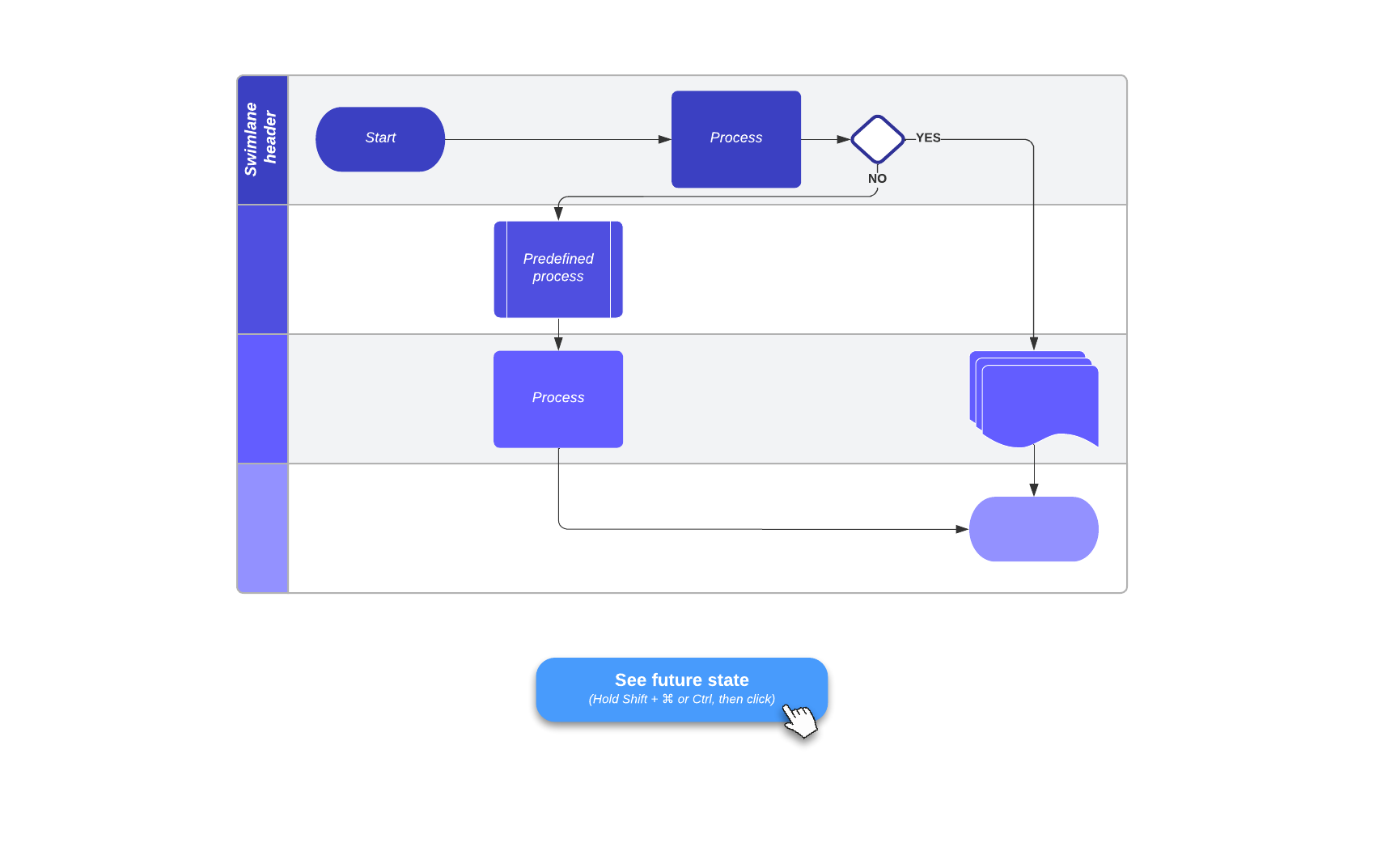
The importance of current state mapping when scaling your architecture
Reading time: about 6 min
Most businesses see the value and importance of developing software using some flavor of Agile methodology. Until recently, Agile was seen as something that software development teams do while the rest of the company continues to work the same way they always have.
But the COVID-19 pandemic changed the way we live and work. Companies had to quickly adapt and figure out how to work in an increasingly distributed, digital environment as a majority of their workforce worked remotely. According to the 15th Annual State of Agile Report, distributed work models are here to stay:
- Only 3% of respondents plan to return to the office full time.
- 25% plan to stay remote full time.
- 56% prefer a hybrid model with a mixture of office-based and remote work.
Businesses are seeing the need to adopt Agile practices not only in software development, but also for teams such as business strategy, finance, HR, marketing, and so on. To be successful in the new digital age, the entire company needs to be more agile.
For the whole company to be agile, you need an architecture that can support agile development. In this article, we will discuss what it means for an enterprise architecture (EA) to be agile. And we’ll look at why you need to map and maintain your EA’s current state so you always know what you have. This will help you to understand what you need so you can make more informed decisions that keep systems running to meet internal and external customer needs.
What is agile enterprise architecture?
Traditionally, EA is used like a blueprint of a company’s structure and operation with the focus mainly on technology optimization and standardization. This capability-centric approach ensured that everybody had adequate hardware and the most current operating system and software needed to successfully do their work. The architects created and maintained an architecture that helped them to easily deploy updates with minimal disruption or downtime.
As a result, traditional EA is a more structured and rigid framework. It works well for servicing internal customers, but it was not designed to be flexible or responsive to rapidly changing demands and needs from internal and external customers and stakeholders in a digital world. But changes are going to continue to increase, especially as we keep looking for ways to automate, streamline, and improve the way we work.
And all of this means that an agile EA design approach needs to come from a collaborative and flexible perspective. The focus needs to shift from technology to modernization and innovation so you can rapidly scale up and down to meet rapidly changing needs. And at the same time, the architecture still needs to enable optimization, standardization, and compliance.
The agile EA model is driven by business outcomes and services that are customer-centric rather than being driven by business capabilities. This means that architects won’t be relegated to the outskirts of different projects. They will be more distributed and assigned to various project teams where they can be involved in the initial planning phases. And like the rest of their project team, they will work in a faster, iterative model and attend frequent status meetings to manage progress and dependabilities.
Why is an agile enterprise architecture important for delivering competitive products?
A traditional EA can impede and slow down your ability to deliver high-quality innovation quickly and consistently. Applying Agile practices to your enterprise architecture opens up architectural designs to increased collaboration across multiple teams, more flexibility, and better responsiveness so you can align with faster change cycles.
If you don’t find a way to make your architecture more agile, you might find yourself lost in the dust of your competition. So it’s important that you put together a team that can:
- Focus more on customer experience.
- Align more closely with business strategies, processes, and output.
- Reduce complexity so you can design and work in short, iterative development cycles.
- Ensure enterprise-wide consistency of technologies, processes, and procedures.
- Focus on products and services instead of projects.
- Ensure that the EA is scalable and adaptable to meet internal and external customer needs.
- Support DevOps and continuous deployment by working in an environment of continuous improvement, responding rapidly to change, and being open to feedback and continuous learning.
- Find ways to automate some of the more traditional EA roles.
- Restructure EA teams based on services rather than domains and technology.
- Document everything to benefit new hires or transfers from other departments and to ensure that vital knowledge is not lost when subject matter experts move on to other business opportunities.
Where do you start?
Transforming to Agile practices does not happen overnight. Getting top-down buy-in and rethinking your approach to architectural design is going to take some time. But a good place to start is understanding your current system state. Knowing what you already have helps to take the guesswork out of determining what you’re going to need to create a flexible and responsive framework.
And one of the best ways to understand your current state is to visualize it. Using visuals gives you a high-level overview of how your architecture currently works. This gives you better insight into where improvements can be made and helps you to make informative decisions.
Why mapping your current state matters
Creating a visual map of your organization’s architecture helps you to see the system’s current state. It’s generally easier to present technical information visually because people can interpret the information quickly and retain the knowledge for a longer time.
In addition, current state mapping matters because:
- You need to understand your current state before you can scale your architecture. If you don’t know what you have, you’re only guessing at what you need. Or, you could end up wasting valuable time recreating components that already exist.
- A current state map helps you to learn fast and more quickly understand your organization’s architecture so you can make well-informed, agile decisions.
- Creating a current state map is a good start for documenting your architecture. Agile emphasizes creating working software over writing comprehensive documentation. But you still need documentation in an agile environment. You need to document the architecture structure, its components, relationships, processes, and so on. The documentation is useful for new employees, training, and ensuring consistency across the enterprise.
Try a current state mapping template to get a head start on mapping your system.

Keep in mind, creating an agile EA should be part of a collaborative effort. It’s important to collaborate on the documentation as well. Visual documentation helps everybody involved to more quickly arrive at a shared understanding.
In addition, current state mapping helps you:
- Determine the prioritization, resources, and capability requirements for projects that you want to transform to agile.
- Understand which software/tools are required for specific organizational processes.
- Understand relationships and dependabilities between various components and applications within the architecture. This will give you a better idea of what might happen if you were to remove applications from your tech stack.
- Discover where you might be able to streamline processes with automation.
- Create value stream maps to do a quick analysis of processes so you can identify where things are slowing down, if there are redundancies, and if there are areas that can be simplified.

Now that you've explored the importance of current state mapping, learn how to do it!
Read moreAbout Lucidchart
Lucidchart, a cloud-based intelligent diagramming application, is a core component of Lucid Software's Visual Collaboration Suite. This intuitive, cloud-based solution empowers teams to collaborate in real-time to build flowcharts, mockups, UML diagrams, customer journey maps, and more. Lucidchart propels teams forward to build the future faster. Lucid is proud to serve top businesses around the world, including customers such as Google, GE, and NBC Universal, and 99% of the Fortune 500. Lucid partners with industry leaders, including Google, Atlassian, and Microsoft. Since its founding, Lucid has received numerous awards for its products, business, and workplace culture. For more information, visit lucidchart.com.
Related articles
How to map your current state before scaling your architecture
In this article, we’ll discuss what a current state map should include and some of the available tools and software that you can use to map your current state.
Mapping your current state with Lucidchart
In this article, we will walk you through the process of creating a visual current state map using Lucidchart.
